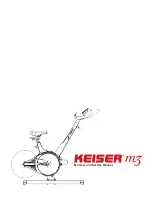
11
EXERCISE GUIDELINES
ATTENTION:
• Please consult with your doctor before
beginning this or any other workout
programme. This is especially important for
persons aged over 35 years or persons with
pre-existing health problems.
• Heart monitors are not medical devices.
Several factors can make the heart rate
reading less accurate. Monitors only give an
approximate idea of heart rate fluctuations
during exercise.
The following exercises will help you to organise your
workout programme. It is important to remember that
a proper diet and adequate rest are essential for
good results.
TRAINING INTENSITY
Whether your goal is to burn fat or to strengthen
your cardiovascular system, the key to achieving
the desired results is to train at the correct intensity.
The correct intensity level can be found by using
your heart rate as a reference point. The table below
indicates the recommended heart rates for burning
fat and for aerobic exercise.
To determine the required heart rate, first find your
age at the bottom of the table (ages are rounded to
the nearest ten). Next, find the three numbers above
your age. These three numbers are your "training
zone". The lowest number is your recommended
heart rate for burning fat, the middle number is your
recommended heart rate for burning even more fat,
and the highest number is your recommended heart
rate for aerobic exercise.
Burning Fat
In order to burn fat effectively, you must exercise at
a relatively low intensity for a long period of time.
For the first few minutes of exercise, your body uses
calories from carbohydrates, which are an easily
accessible energy source. After just a few minutes,
your body begins to use calories from fat stores as
an energy source. If your goal is to burn fat, adjust
the intensity of your training until your heart rate is
between the lowest number and the middle number
in your training zone while you train.
Aerobic Exercise
If your goal is to strengthen your cardiovascular
system, your training should be aerobic.
Aerobic exercise requires a large amount of oxygen
for a prolonged period of time. This increases the
amount of blood that the heart must pump to the
muscles, and the amount of blood that must be
oxygenated by the lungs. For aerobic exercise, adjust
the intensity of your workout until your heart rate is
close to the highest number in your training zone.
EXERCISE GUIDE
Each training session should include three steps:
Warming Up
Start each training session with 5 to
10 minutes of stretching and light exercise. A proper
warm-up will raise your body temperature and
increase your heart rate and circulation, to prepare
you for training.
Exercise in the Training Zone,
once you have
warmed up, increase the intensity of your exercise
until your heart rate in is the training zone for 20 to
30 minutes. Note:
for the first few weeks of exercising, do not keep
your heart rate in your training zone for more than
20 minutes.
Cool-down Exercises
, finish each training session
with 5 to 10 minutes of stretching in order to return to
normal. This will increase the flexibility of your muscles
and help you to prevent the problems that can occur
after exercise.
TRAINING FREQUENCY
To maintain or improve your physical fitness, work
out three times per week, with at least one day of rest
between workouts. After a few months, you may work
out up to five times per week if you wish.


































